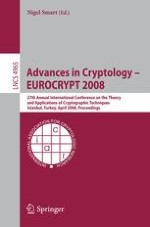2008 | Book
Advances in Cryptology – EUROCRYPT 2008
27th Annual International Conference on the Theory and Applications of Cryptographic Techniques, Istanbul, Turkey, April 13-17, 2008. Proceedings
Editor: Nigel Smart
Publisher: Springer Berlin Heidelberg
Book Series : Lecture Notes in Computer Science
